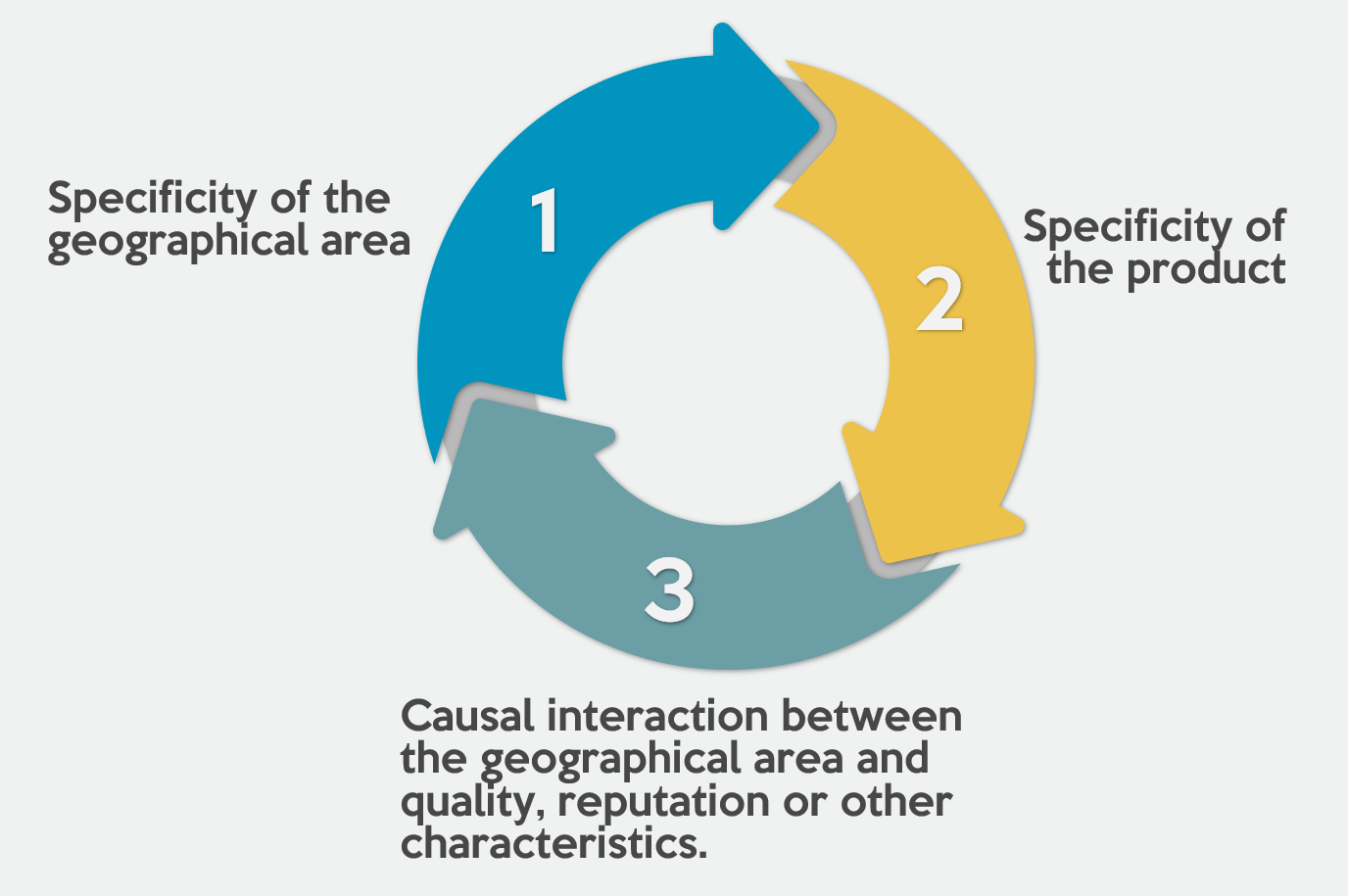Session 3.1 Geographical Indications specifications
Overview
This session focuses on developing Geographical Indications specifications and provides information on the various elements of the specifications.
Several case examples will be used to reinforce the concepts being taught. Learning exercises will be used throughout the session to allow participants to apply the knowledge transferred during each section.
Session learning objectives
This session has as its key objectives:
Session learning outcomes
By the end of the session participants will be able to:
Conditions for a product to be eligible for GI protection
Content of Geographical Indications specifications
Specifications are essential for the protection of goods or services using GIs. The product specification is elaborated by the GI producer group and is a shared definition of the production and processing practices used by a group of producers in the geographical area. The OLP specifications provide objective and impartial information on the GI product.
Content of GI specifications
The GI specifications must contain the following elements:
- The name of the GI
- The type / category of the product for which the name is protected
- The applicant’s information
- The protection in the country of origin, if necessary
- A description of the product
- A definition of the geographical area
- A description of the production methods
- Information on traceability and evidence of the origin
- The link between the product and the geographical area
- Specific rules concerning the labelling of the product
- And information concerning the control body, and the control processes
The following further explains these key elements.
The name of the Geographical Indication
The GI name refers to a geographical name such as a country, region, district, city etc. The name of the GI is a common designation used by producers within a specific geographical area of production. It is often a common name used by producers in trade and has a reputation and connection with the specific group of producers and the production area. The name of the GI cannot be new or fanciful as it would then be more appropriate to apply for a trade mark.
The type or category of the product for which the name is protected
This section of the specifications deals with the type or the category of the product. It can be a legal definition of the category as may be defined in the national legislation, or at the regional level e.g. the EU.
The applicant
Here information is provided on the entity making the application for registration of the GI. The applicant is the GI group of producers or any competent legal person as defined in the national legal framework for registering GIs. As requirements may differ depending on the legal framework it is important to know precisely what is required to develop the specifications in the country of interest.
Protection in the country of origin
This relates to the protection of foreign GIs. The GI product must be protected in its country of origin before applying in other countries.
Description of the product
In this section the technical description of the product is presented. This technical description is derived by consensus among the members of the producer group, and it has as a primary aim distinguishing the GI product from other products of the same category. Information presented in this section can include: the type of product (e.g. fresh or processed product), the shape, the weight, the size, the colour, the taste or physical / chemical properties.
For processed products information on raw materials is provided if the consensus is that the raw material information is relevant. Information can also be provided on plant varieties and animal breeds if relevant. In describing the product, producers can also document information on how the product is presented, noting whether it is fresh, processed, sliced, frozen or packaged.
Geographical area
In elaborating the specifications for the OLP, producers will also have to provide information on the geographical area of production. Here a detailed description is given of the delimitation of the geographical area that must be covered by the Geographical Indication. This description will include all the steps of production that must take place within this area. It will be useful to provide a map, to identify the location of the geographical area clearly and easily. The geographical area must also be consistent with the definition of the link identified.
Description of the production methods
In this section, a clear and concise description is made of the conditions of production. Examples include:
The key elements of the production method will be later converted to control points to be checked by a control body during monitoring procedures, therefore, it is important to avoid including uncontrollable elements which cannot be checked and verified for conformity.

Traceability and evidence on origin
Here there are two key areas where information is required:
In terms of traceability, it is important to consider the reporting obligations which will be required including for example the results of the control assessment and analysis, evidence supporting compliance to control check points in the control system, and the link between the product and the origin.
The link between the product and the geographical area
This is a particularly important area of the specifications. In this section producers will provide the description of the causal link between the geographical area and the specific quality, reputation or other characteristics of the product. Consideration must be given to factors such as natural conditions (geography, soil, climate, local varieties, breeds, biodiversity, landscape, etc.); human factors (know-how, tradition, common practices); product reputation and even the reputation of the area. Anything which will give specificity to the product compared to similar products from other geographical areas should be considered and documented.

Specific rules, concerning labelling of the product
In this section, the rules in relation to the use of the GI logo and name in labelling of the product is provided. Explanation can also be given on how to integrate the use of specific trade marks combined with the Geographical Indication.
Control body/Control Authority responsible for checking compliance of product specifications
Here information on the name of the control authority is documented. If a certification body is being used, then reference to the accreditation number of the certification body and other relevant details are provided.
Learning exercises
Question 1: I produce a new sauce in Jamaica, I want to name it “Jamaican sauce”. Can I register it as a GI?

No. If the product is new and has no characteristics and/or no reputation, it is usually not eligible for protection as a GI.
Question 2: Can I apply for the GI in relation to ceramic products if the raw material does not come from the geographical area?
Yes. The raw material is not compulsory for a GI, except if the raw material is linked with the specificity/quality of the final product. If the ceramic product manufacturing techniques are based on traditional know-how and / or reputation, these conditions are sufficient to make the GI feasible.
Question 3: A single producer can apply for GI?
It depends on the country/jurisdiction.
Yes: If the legal framework contains a provision which makes it possible for a single producer to apply for a GI.
No: If there is no reference in the legal framework of the single producer option.
Question 4: If the product is not registered as a GI in its country of origin, can a GI be applied for in another country?
No. If the GI or equivalent sign is not registered or recognised in its country of origin, it cannot be protected as a GI in another country.
Question 5: If the product is not registered as a GI in its country of origin, but as a collective trademark, can a GI be applied for in the EU?
Yes. The EU legal framework, it covers the recognition of collective trademarks as a Geographical Indication.
Question 6: In the description of the product, can I say that my product is the best one?
No. The description of the product must only contain objective elements that can be checked afterwards by the control body.
Question 7: Is the description of the shape, size, colour of the product compulsory?
No. The description of the shape, the size, the colour, etc., is compulsory only if it is a component of the product specificity.
Question 8: Because of provisions in the GI specifications related to traceability and protection of the quality of the product, I need to undertake slicing and packaging of the product within the geographical area. Am I entitled to do so?
Yes. Slicing and packaging can be restricted within the geographical area of the GI. Such a provision will be provided for in the product specifications developed by the producers. Including these elements and making provision for their verification for conformity as part of the control process will enhance traceability and consumer confidence in the product.
Question 9: Is it mandatory that the geographical area of production of the GI correspond to administrative definition/boundaries?
No. Administrative boundaries evolve over time and change their name as well. For example, Café de Valdesia could be produced in a territory that is not 100% corresponding to the administrative borders of the Valdesia region in Dominican Republic. As long as the territory where the GI can be produced is clearly identified it must not correspond to the administrative boarders. In addition, borders can be integrated in the GI geographical area. Cross-border GIs can also exist.
Question 10: Must the raw material come from the geographical area?
No. It is not compulsory and will depend on the product and its specificities.
Question 11: In relation to the product-territory link, we have integrated in the specifications many paragraphs in relation to natural factors. These natural factors are not directly related to the quality of the GI product. Should we maintain them?
No. The link paragraph must clearly explain the relevant interactions between the geographical area and the product. If natural factors are not linked directly with the quality of the product, it is not necessary to include them in the explanation about the link.
